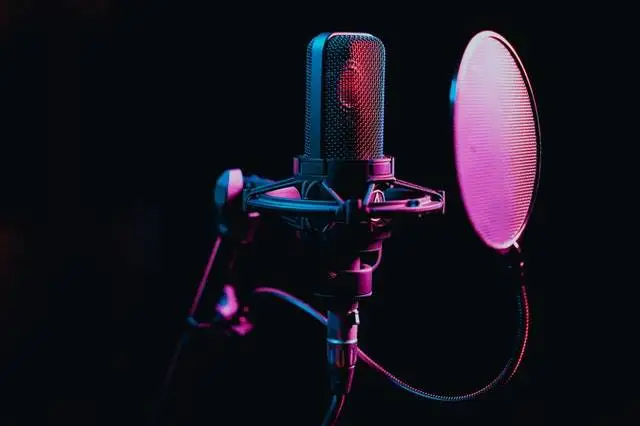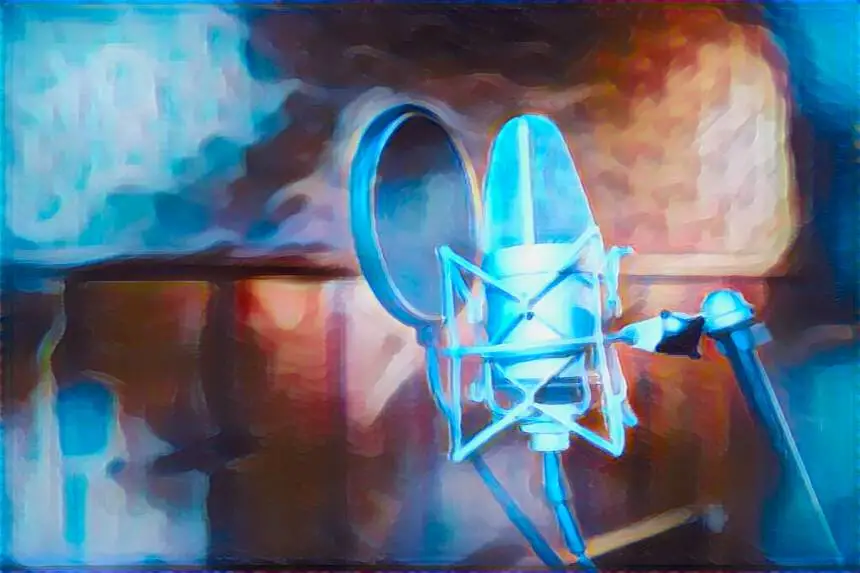Sick of all those annoying pops and clicks ruining your vocal take?
You probably need to get yourself a pop filter .
When it comes to recording vocals, a pop filter is just as important as the microphone itself.
Continue reading to learn more about pop filters, why you need one, how to use one, and the various available kinds.
What Is A Pop Filter?
While pop filters come in many different shapes and sizes, they are typically circular devices made of plastic or metal with a thin layer of mesh that a singer positions a few inches in front of the microphone.
Pop filters typically come with adjustable arms and microphone stand mounts so that you can position them based on where the vocalist is standing or sitting.
What Does a Pop Filter Do?
There are two primary purposes for pop filters, including:
- The elimination of popping sounds (otherwise known as plosives)
- The limitation of saliva contact with the microphone
Popping noises or plosives come from words with hard consonants at the front, such as the consonant " p. "
With a sudden burst of air pressure, a hard 'p' can overload your microphone. If you're dealing with a sensitive microphone, such as a ribbon microphone, these hard consonants could do damage.
To eliminate this sudden burst of air, recording engineers will place pop filters in front of the microphone.
As for the second purpose, preventing saliva from getting on the microphone, pop filters can be beneficial.
Not only do we not want to have to clean and disinfect our microphones all the time, especially if we have multiple singers using the microphone, but saliva carries salt and other corrosive content. By mitigating saliva's contact with your microphone, you can prolong its life.
Types Of Pop Filters
There are two main types of pop filters out there:
- Nylon Mesh Pop Filters
- Thin Metal Pop Filters
Nylon pop filters have been used in professional recording studios for many decades at this point, as they are both inexpensive and effective .
Depending on the type of mesh filter you get, you will likely spend around $20 .
Many recording engineers believe that these types of filters reduce top-end, darkening the vocal recording . For this reason, microphone pop filter manufacturers started crafting metal pop filters .
These fairly recent innovations are much tougher than nylon mesh pop filters. Plus, they are very easy to clean, allowing you to rid your pop filter of spit and other unwanted bacteria after a dozen singers have used it.
While there aren't many formal tests, many people believe metal pop filters can give you a more accurate sound .
You should expect to spend a bit more on a metal pop filter, as they go for about $50 on average.

Does Every Singer Need a Pop Filter?
Not necessarily.
You can avoid having to use a microphone pop filter by tilting your microphone slightly off-axis . With this technique, the vocalist won't sing directly into the microphone but rather a few degrees off.
When employed correctly, this technique can reduce problematic plosives.
A good pop filter can reduce vocal brightness, which is something to keep in mind if your vocal sounds dull. Of course, dullness usually stems from the microphone, though it might be worth experimenting without a pop filter.
How To Use A Pop Filter
Understanding how to use a pop filter is all about knowing how to position one.
As a good rule of thumb, you should position your pop filter one fist length from the microphone (pinky to thumb).
You want to place your pop filter in a way that it is between the front of the microphone and the vocalist's mouth, as the pop filter should block out the plosives from reaching the microphone's diagram, so you don't get that annoying popping sound.
The next logical question would be,
Where do I place the vocalist in relation to the pop filter?
The answer to that question is: it varies .
Similar to standard microphone placement , you'll base it on the vocalist. Typically , we suggest having a singer start about 5-6 inches away from the pop filter and adjusting based on the sound.
Pop Filter Vs. Windscreen
Wondering whether you can use a windscreen instead of a pop filter?
The answer is no .
A windscreen, otherwise known as a pop screen, is a cylindrical piece of foam that you stick on the microphone capsule when you're recording in an outdoor environment.
Windscreens, as the name implies, are used to deflect wind. You'll typically find these in use on film shoots, outdoor concerts, or interviews.
While they block out wind really well, they cannot block out the fast-moving air that comes from a plosive. What they will do is reduce the top-end on your vocal, making it sound quite dull.
What To Look For When Buying a Pop Filter
Size
The first thing that you'll probably want to consider when buying a pop filter is the size. You want it to be proportional in relation to your microphone. Think about the kinds of singers you work with as well.
Do they move around a lot while singing?
If so, you might want to get a larger pop filter with a wide diameter to account for additional movement.
Gooseneck Length
Most pop shields come with gooseneck designs, allowing you to manipulate them and get the correct placement. Depending on your setup, you might need a longer gooseneck to get the pop filter in front of the microphone. Make sure to check the specs for the neck length.
Clamp Type
Some pop filters come with clamps, allowing you to attach them to microphone stands. You need to consider the type of stand you have and whether the clamp is compatible. If you decide that you want to attach your clamp to a different structure than your microphone stand, consider that as well.

Screen Type
We spoke about this early in the article, but choosing between nylon mesh and metal is an important decision.
Superimposed nylon pop filters are wonderful for restraining plosives and are very inexpensive. However, they are much more challenging to clean, cut off top-end, and have low lifespans.
Metallic pop filters, on the other hand, are great for blocking out plosives while retaining high-end. They are also very easy to clean.
However, they come at a premium price. If the metal bends, it could be difficult to bend back into shape. In addition, a bent metal filter won't be nearly as effective.
Do note that there are some higher-end filters out there that come with dual screens , meaning you get one metal screen and one mesh screen.
Can You Make Your Own Pop Filter?
Yes, you can 100% make a DIY pop filter, and it's quite easy to do so.
The only thing you need to make a homemade pop filter is a wire coat hanger and a cheap pair of pantyhose.
Bend your wire coat hanger into a small circular shape and place yo pantyhose over it. You can then take the additional length from the wire hanger and wrap it around your microphone stand, so it stays in place.
Pop Filter Alternatives
If you're ever in a pinch and you don't have a pop filter to put to use, there are a couple of handy alternatives you can use.
Many engineers use pencils to block out plosive sounds. Simply take a pencil and place it vertically on the face of the microphone capsule. Then, use a rubber band to secure the pencil to the microphone.
The pencil will displace incoming air and plosive energy so that it doesn't hit the mic capsule in a concentrated fashion.
A sock can be an effective pop filter when fit snugly atop microphones as well.
Just make sure that sock is clean, or you could risk a mid-session faint.
FAQS
Does a Pop Filter Reduce Background Noise?
No. A pop filter is only made to block out plosive sounds, not minimize room noise. If you want to eliminate background noise, consider treating your room with acoustic treatment .
Do I Need Both A Windscreen and a Pop Filter?
There is no reason to use a windscreen and a pop filter at the same time. Both of these tools are made to reduce unwanted noise, though you will use one or the other depending on where you're at. Windscreens are better for recording outdoors, and blocking out wind while using a pop filter is best when trying to get rid of pops and plosive issues.
Do You Need a Pop filter For Live Performance?
You can utilize a pop filter for live performance, though many microphones come with pop filters built-in. One of the most popular live microphones is the Shure SM-58, which comes with a built-in filter.
Can I Use a Sock As a Pop Filter?
Yes, you can use a sock as a pop filter, though you will need to get a thin sock. A decent pop filter must be made out of acoustically semi-transparent material. If you use a very thick sock, it could dull the sound of your voice.
How Do You Clean a Pop Filter?
If you have a pop filter made of metallic mesh, you can clean it with warm water and soap. Make sure to dry it completely when you're done cleaning it. If you have a pop filter made of woven nylon, your best bet is to spray it with some sort of air freshener, such as Febreze.
How Do You Keep a Pop Filter From Falling?
If your pop filter doesn't stay in place on your mic stand, you can use sturdy tape, such as gaffer tape or duct tape, to keep it in place. You may also consider hanging your pop shield over the microphone so that it hangs down, allowing gravity to do its work.
Do Pop Filters Help With Sibilance?
While most pop filters are great for limiting plosives, such as 'p's and 'b's, most of them are not made to get rid of sibilance. If you're getting too much sibilance in your recordings, consider how close the vocalist is to the microphone diagram and use a de-esser in post-production.





